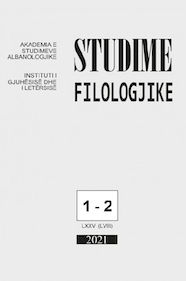Marrëdhëniet ndërmjet toponimeve dhe fjalëve të trashëguara të Shqipes sipas analizës së zhvillimit të tyre fonetik dhe faktorëve të tjerë ndikues
The Relationships Between Toponyms and Inherited Albanian Words According to The Analysis of Their Phonetic Development and Other Influencing Factors
Author(s): Genc LafeSubject(s): Language studies, Theoretical Linguistics, Phonetics / Phonology, Philology
Published by: Qendra e Studimeve Albanologjike
Keywords: Albanian language; phonology; phonetics; toponyms;
Summary/Abstract: The article starts by examining the phonetic evolution of two ancient Albanian appellatives, dallëndyshe (from a base *dalland-, not of PIE origin, cf. gr. χελῖδών, lat. hirundo and also the name of an Illyrian tribe, Chelidónioi, probably a gr. exonym for the Taulantii) and ngjalë ‘eel’, which surface in the ancient ethnonyms of two Illyrian tribes, the Taulantii and the Enchelei. Their phonetic evolution has unfolded according to the Albanian phonological laws. On the other side, the evolution of ancient toponyms, hydronyms and oronyms mainly from Northern Albania, since their earliest attested forms up to the actual ones (Scodra, Durrhachium, Lissos, Oulkìnion/Olc[h]inium, Scordos mons/Skárdon óros and Scampinus, in Albanian respectively Shkodër, Durrës, Lezhë [older Leshë, Lesh], Ulqin, Sharr and Shkumbin), shows a rather Latin loanword-like (lehnwörtlich) development, similar to the numerous Latin loanwords in Albanian, than an inherited (erbwörtlich) one, or allegedly of Latin descent (the oronym Sharr, from late lat. serra ‘mountain range’, cf. it. serra, sp. sierra). On this basis it has been inferred (in recent works of J. Matzinger) that the speakers of Proto-Albanian reached the area starting from approximatively the 1st century AD, when the Latin influence on the (Proto)Albanian entered a highly intense period which has resulted in the influx of a large number of Latin loanwords practically in all Albanian lexical domains. Even an ancient onym, Mat, with an inherited (erbwörtlich) development dating back to PIE *mn̥-ti- ‘mountain’ is considered to have not appeared earlier, in spite of the fact that formally Mat could have appeared any time long ago before the Latin period in Proto-Albanian, conserving the same phonetic shape. There are also oikonyms which seem to have evolved according to Albanian phonological laws (Niš, in Serbia, from Naissos, through alb. *Nëish → Nish [cf. lat. padule(m) → *pëyll → pyll ‘forest’] and Štip in Northern Macedonia from Ástibos). However, their phonologic development shows the same pattern of the Latin loanwords; very ancient substitutions such as *sk → h and *sp → f, which can be reconstructed for PIE roots in Albanian, are absent in the Albanian-related toponymy. In our analysis we have tried to show that, unlike the appellatives, which evolve according to the phonology of their own language, in areas with plurilingualism the toponyms are subject to the pressure of the predominant language(s) in the use. This is the case of the Latin in the Balkan Peninsula in the antiquity. We have shown that such a pressure (mainly Italian, but also Turkish) has reshaped various Albanian and foreign toponyms in the Albanian linguistic use. The same must have surely happened also in the remote Latin antiquity, generating a divergent phonetic evolution regarding the expected outcome of the toponyms. This parameter shouldn’t be ignored while coping with this problem. Other factors which also influence the form of the toponyms are the mobility of prehistoric populations and the time gap between the earliest periods of Proto-Albanian and the first attested toponymy records in the Balkan Peninsula.
Journal: Studime Filologjike
- Issue Year: 2021
- Issue No: 01-02
- Page Range: 37-58
- Page Count: 22
- Language: Albanian

